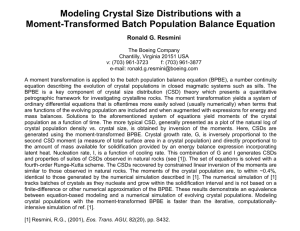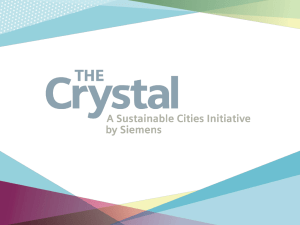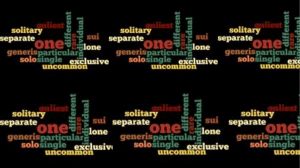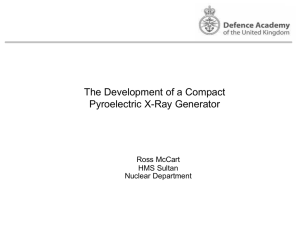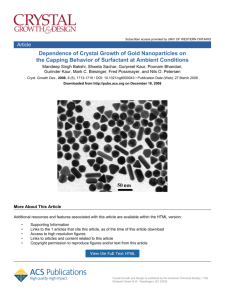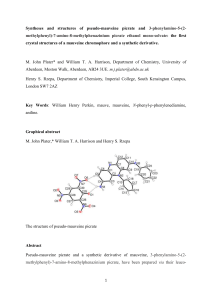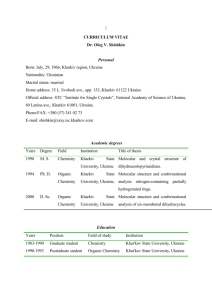Title Crystal structure prediction dataset for SiO2, atmospheric
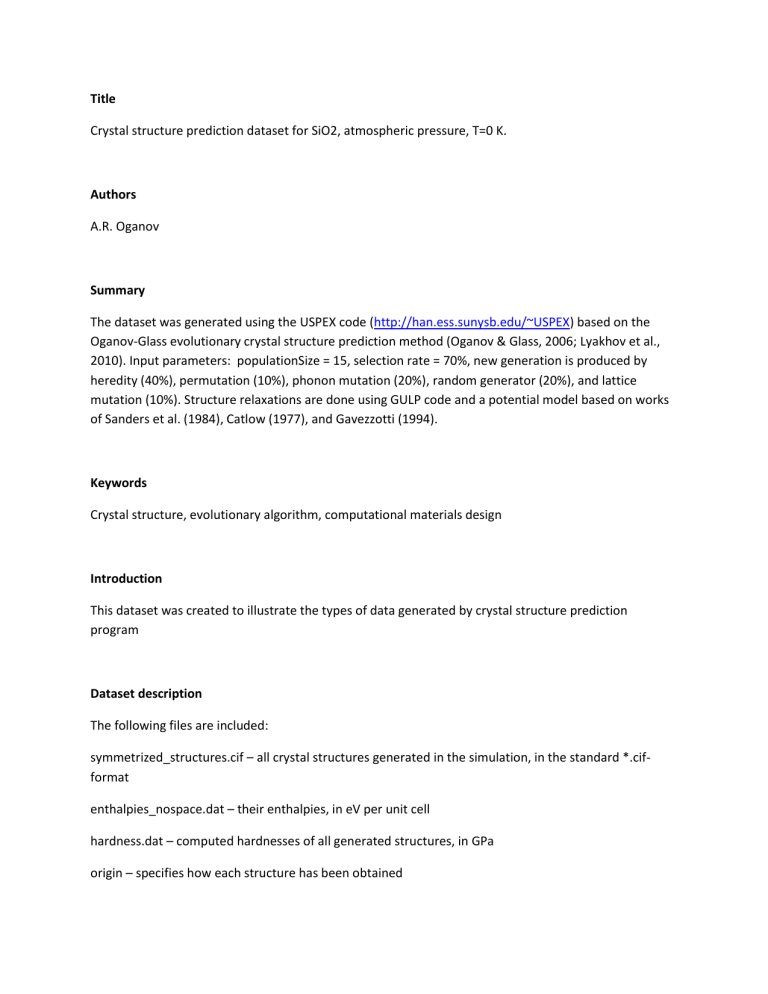
Title
Crystal structure prediction dataset for SiO2, atmospheric pressure, T=0 K.
Authors
A.R. Oganov
Summary
The dataset was generated using the USPEX code ( http://han.ess.sunysb.edu/~USPEX ) based on the
Oganov-Glass evolutionary crystal structure prediction method (Oganov & Glass, 2006; Lyakhov et al.,
2010). Input parameters: populationSize = 15, selection rate = 70%, new generation is produced by heredity (40%), permutation (10%), phonon mutation (20%), random generator (20%), and lattice mutation (10%). Structure relaxations are done using GULP code and a potential model based on works of Sanders et al. (1984), Catlow (1977), and Gavezzotti (1994).
Keywords
Crystal structure, evolutionary algorithm, computational materials design
Introduction
This dataset was created to illustrate the types of data generated by crystal structure prediction program
Dataset description
The following files are included: symmetrized_structures.cif – all crystal structures generated in the simulation, in the standard *.cifformat enthalpies_nospace.dat – their enthalpies, in eV per unit cell hardness.dat – computed hardnesses of all generated structures, in GPa origin – specifies how each structure has been obtained
Parameters.txt – input parameters for the evolutionary algorithm ginput – file with specifications of how the structures are relaxed and how the energy is computed (in this case, using the GULP code)
This and similar datasets play an important role in testing and benchmarking crystal structure prediction methods.
Data availability
Data files are available at: http://han.ess.sunysb.edu/~aoganov/NPG-data-template/
Related datasets
None so far
Related publications
None so far
Data providence / Author contributions
The data have been generated by Artem R. Oganov using USPEX code, v.8.7.1.
Prof. Artem R. Oganov, Department of Geosciences and Department of Physics and Astronomy, State
University of New York, Stony Brook, NY 11794-2100.
Phones: (631)-632-1429 (office), x1449 (lab), x8241 (admin. assistant). Fax (631) 632 8240.
E-mail artem.oganov@sunysb.edu. Web-site: http://mysbfiles.stonybrook.edu/~aoganov
Data description
The data have been obtained on a Linux PC. The lowest-enthalpy structure corresponds to the thermodynamically stable state.
The graphs below show how the energy evolves during the structure searching run, and how it correlates with volume (the latter helps to find candidate structures that may be stable at different conditions).
Data processing
The data given here are easy to analyze. One should exclude duplicate structures and rank the remaining structures by enthalpy. This can be conveniently done using structure fingerprints (Oganov & Valle,
2009) as implemented in the freely distributed STM4 code: http://personal.cscs.ch/~mvalle/STM4/index.html
Data updates
Will be posted at: http://han.ess.sunysb.edu/~aoganov/NPG-data-template/
Usage and tools
The data can be used for benchmarking and improving the performance of crystal structure prediction methods. Such datasets, based on empirical interatomic potentials, can be generated relatively quickly, enabling considerable statistics necessary for robust conclusions.
The lowest-enthalpy structure is the predicted stable state at T= 0 K, within the accuracy of the approximation used for energy calculations. Also of interest are low-enthalpy metastable structures, abundantly present in such datasets. Analyzing these structures, one gets a deep insight into the chemistry of the given compound. Analysis of various structure-energy correlations and of energy landscapes (Oganov & Valle, 2009) brings additional insight.
One should also remark that empirical potentials seldom reach sufficient accuracy for unequivocal conclusions as to which structure is the thermodynamically stable one. For such conclusions it is usually better to relax the structures and compute their energies using quantum-mechanical methods/codes – such codes as VASP, Quantum Espresso, SIESTA are interfaced with USPEX, and datasets similar to this one can be generated, although at a higher computational cost.
Competing financial interests
The authors declare that they have no competing financial interests
Funder and grant number
DARPA (grant N66001-10-1-4037)
Acknowledgments
Andriy O. Lyakhov and Qiang Zhu have coded the latest version of USPEX (v.8.7.1).
References
Oganov A.R., Glass C.W. (2006). Crystal structure prediction using ab initio evolutionary techniques: principles and applications. J. Chem. Phys.
124 , art. 244704.
Lyakhov A.O., Oganov A.R., Valle M. (2010). How to predict very large and complex crystal structures.
Comp. Phys. Comm.
181 , 1623-1632
Sanders M.J., Leslie M., & Catlow C.R.A.(1984). Interatomic potentials for SiO2. J. Chem. Soc., Chem.
Commun. 19 , 1271-1273.
Catlow C.R.A. (1977). Point defect and electronic properties of uranium dioxide. Proc. Roy. Soc. Lond.
A353 , 533-561.
Gavezzotti A. (1994). Are crystal structures predictable? Acc. Chem. Res. 27 , 309-314.
Oganov A.R., Valle M. (2009). How to quantify energy landscapes of solids. J. Chem. Phys. 130 , 104504.



